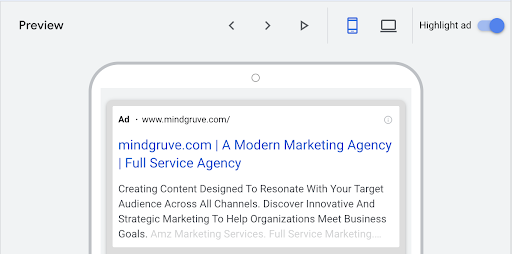The era of Expanded Text Ads ends June 30th, 2022. Advertisers will no longer be able to create or edit this existing ad type, and instead must utilize Responsive Search Ads (RSAs). RSAs have been available for some time now, and most advertisers have probably already begun testing and adopting them. That said, a refresher on best practices never hurts, and RSAs provide a total of 15 headlines to test. Here are our quick tips to get you on the right track.
How to Maximize Your Headline Effort
1. Match the headline with the keyword.
This is not unlike Expanded Text Ads. However, be wary of overdoing it. Redundancy won’t work in your favor.
2. Be cognizant of what headlines may get paired together.
If the keywords or messaging are too similar, they may be bundled. For example: Houses for Sale, Homes For Sale, Family Homes For Sale, and New Houses For Sale will be paired together. You risk losing impressions that you would gain otherwise.
3. The more unique the headlines are, the better.
Add variety by including your brand name, slogan, benefits, promotions or offers, features, awards, location, and more. The goal is to maximize campaign performance by showing up in as many search results as possible.
4. Include CTAs that match the intent of the search and/or action that you want users to take.
Give them a clear next step. For example, an apartment or condominium firm may employ CTAs like “Book a Tour” or “View Floor Plans.”
5. Headlines should be unique, but tell a cohesive story.
Think of each headline as a jigsaw piece. When put together, they should create a singular, clear picture. Use the ad preview tool to rotate through headline combinations and assess if they fit.

6. Aim for 10 headlines at minimum.
Usually, the more headlines you utilize, the better your performance will be. And, it allows Google to identify more winning combinations.
7. Use the suggestions in the ad creation interface.
It shows where there is opportunity to improve ads, and can also help spark new ideas.

8. Repurpose copy from your landing page.
You worked hard on it, and it’s good content — so take advantage of that asset. If you need to, reword and adjust website copy to fit within the character limit.
9. Be creative.
This is time to test messaging you wouldn’t normally use. You might find a winner. Take a few risks here and see what works (or doesn’t).
One final tip: Optimize description lines.
Regarding the four description lines, the same ideas above apply. Match the messaging to the keyword, include a call to action, and don’t be redundant. Really, the only thing you don’t want are two almost identical descriptions being shown together.
Conclusion
With these tips, we hope the transition to Responsive Search Ads isn’t as daunting of a task. With a little practice and testing you will soon become familiar with how they work. They do require more planning and strategic thought than traditional Expanded Text Ads, but the bolstered performance is certainly worth the effort.